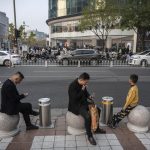
For those who reside under the dry Arizona heat in the small border town of Sierra Vista between Arizona and Sonora, Mexico, the white surveillance blimp never gives us any respite from the sun. Instead, it serves as a constant reminder: You are being watched.
The blimp rises into the sky before residents wake up and typically dips back down to its asphalt landing before sundown, commanded by a crew of people entirely on land. It floats about 25,000 feet in the air — the length of 700-some school buses or about 69 football fields — and is primarily used to detect low-altitude aircraft. The only time it isn’t in the sky is when it’s too windy for the tether to hold the blimp. When I asked one of my brothers to describe what it looks like, he described it as a nearly 200-foot-long “white cross between a dart and a Vienna sausage” or “a lil sky chode.”
The Tethered Aerostat Radar System (TARS) flies over the Fort Huachuca military base in Sierra Vista, which specializes in unmanned aircraft systems, military intelligence, and cyber security. The TARS provides low-level radar surveillance for the North American Aerospace Defense Command and the U.S. Customs and Border Protection along the U.S.-Mexico border. There are other military bases close to the border that don’t have a TARS, but there are U.S. TARS systems that float above the Straits of Florida and the Caribbean. While data is shared with many agencies, the U.S. Department of Defense is responsible for the lil sky chode. According to the U.S. Customs and Border Protection’s Air and Marine Operations, there are eight TARS sites, which “represent less than 2 percent of the total integrated radars in the Air and Marine Operations Surveillance System,” but account for about half “of all suspect targets detected by radar each year.” The goal — to keep watch over the border — hasn’t been hidden from the residents of Sierra Vista or concealed with secrecy, but is, instead, draped with a thin veil of classic American propaganda.

Credit: Getty images
“This blimp keeps you safe,” U.S. agents would tell kindergarteners on school field trips to the surveillance machine. I went on that tour in 2001, eyes alight with curiosity over what we often called the “white goldfish.” Some older kids called it the “spy balloon” or “anti-drug balloon,” so we always knew it was there for surveillance. It was a frequent character in our games of pretend — if you were hiding, you’d have to also hide from the blimp because it could spot you, too. If it was ever in the sky at night — which was rare — you could detect it by the three red blinking lights, but instead of thinking those lights indicated the blimp itself, we’d debate what kind of UFO was camouflaged.
The ever-present eyes of the border patrol are a staple of life in a border town, in a myriad of ways beyond just the blimp. The majority of my hometown is white (about half) and Hispanic (about a quarter), while the population of Asian and Black people in Sierra Vista is 4.46 percent and 6.91 percent, respectively. You know you’re being watched or being kept safe, depending on which way your immigration status or skin color allows you to view it.
You can tell the white goldfish was built in 1986. It feels like such a retro form of surveillance. You see it directly above your head almost every day of the year, which contrasts blatantly with other tools used to surveil border towns today. Facial recognition technology, hidden underground sensors, and license plate readers blend into the surroundings and don’t appear particularly threatening, even as they make wildly invasive and scary moves using our data and likeness. Like the 160-foot-tall autonomous surveillance towers built in 2018 that pierce the sky every 48 feet along the border, and the U.S. Border Patrol’s immigration checkpoint we’d have to drive through to get from Sierra Vista to Tucson, where we’d go back-to-school shopping or see specialized doctors or buy snacks from Trader Joe’s, TARS didn’t try to hide its efforts to spy. And maybe that was on purpose. Maybe the government wants us to know they’re watching.
I don’t remember everything they told us on the field trip to the blimp, for which the TARS was brought down to the asphalt landing so kindergarteners could tour it and its surrounding control systems. I remember my mom was a chaperone and gave me and my best friend bubble gum on the bus, even though our teacher said we couldn’t have bubble gum on the bus. That was very exciting. I remember the blimp was dark inside, which makes sense because no one is on board when it’s in the sky. It had wires and buttons and mechanical workings throughout, like what I would imagine the control room of a spaceship would be. I remember the man who showed us around was tall and skinny and wore a button-down shirt. He was white and looked more like a flight attendant than an immigration officer, which made sense to me because, to a kid, the blimp seemed more like a plane than a piece of surveillance tech. And I remember how bright it was outside when we left the blimp. The light hurt my eyes — it felt painful and bland, like walking out of a movie theater from an 11 a.m. showing.
My class was not the first gaggle of 5-year-olds who walked through the blimp, nor were we the last. When I spoke to a representative from my school district for this story, she said she didn’t know how many classes had gone on the trip, but she knew it was more than just my own. There were no class trips during COVID, of course, so there hadn’t been a visit to the blimp since at least before 2020. And despite the blimp’s intent to watch us closely, no one keeps track of who visits it. A surveillance blimp in Sierra Vista isn’t a spectacular showing of technology, but an image deliberately intertwined with the fabric of border-town life.
When I asked U.S. Customs and Border Protection why they’d take kids who lived in a border town, many of whom were brown, some of whom were undocumented, and nearly all of whom knew someone who was, on a tour of a blimp built to watch them, I learned that when I was 5 years old, The Department of Defense was in charge of the program. But he added something along the lines of: “Hey, it’s a blimp. That’s interesting! Kids want to know about it!”
And, I’ve got to give it to him, that’s true. I did want to know what it was for, and I don’t recall whether the officers informed us that they were surveilling the town — it was more like telling us they were catching bad guys. Which feels good to kids, until they realize that the “bad guys” people supposedly need protection from are often those same kids’ family members, or even themselves.

Credit: Tori Silva
While brown and undocumented kindergarteners might not recognize that the blimp is a tool of surveillance, as they grow older and learn the specifics of how the TARS works, it becomes a “visual reminder that they are being watched because the government does not trust people who look like them and that there is criminality associated with who they are,” Dr. Nadine Nakamura, a professor at the California School of Professional Psychology, told me.
“Whether the kids and their families are documented or not, U.S. citizens or not, they will be under suspicion because of how they look,” she said. Further, “Discriminatory environments have negative mental health impacts.”
A 2008 study from the National Library of Medicine showed that perceived discrimination has been linked to hypertension, breast cancer, obesity, high blood pressure, and substance abuse. And researchers at UCLA found that when people are chronically treated differently, unfairly, or poorly, “it can have effects ranging from low self-esteem to a higher risk for developing stress-related disorders such as anxiety and depression.”
Arizona already has laws that actively invite racial profiling, like SB 1070, which “requires police officers in Arizona to demand papers proving citizenship or immigration status from people whom they stop, based only on some undefined ‘reasonable suspicion’ that they are in the country unlawfully,” according to the ACLU. Racism is a predominant function of the West. It has shaped Arizona into the place it is; one that gained statehood by colonizing Mexico and led to the rise of the “patriarch of xenophobes” like Joe Arpaio. The blimp hovering overhead is more than a blimp; it’s a reminder of the ramifications of your skin color in a border town.
“A consequence of this is to internalize those messages, [for people] to begin to believe that they don’t belong,” Nakamura said. “This might mean trying to prove belonging, which could also lead to distancing from their communities, and trying to assimilate.”
It can increase the fear that young undocumented kids already have, as well. Psychological distress for children of immigrants is nearly double that of their first-generation immigrant parents, according to one 2020 study. And immigrant families, even documented, experience “resounding levels of fear and uncertainty,” according to the Kaiser Family Foundation. The blimp serves as a “visual reminder that their family members are not safe. Fear of forced separation contributes to psychological distress, including depression and anxiety,” Nakamura said.
Given more recent events, like the expansion of the surveillance technology system at the border, the Dobbs v. Jackson Supreme Court ruling that overturned Roe v. Wade, and the way cities have become surveillance centers, it seems we’re making more moves to abandon the facade of stealthy surveillance and return to the retro blimp’s more public approach of spying — for some communities. Mass surveillance impacts us all, but the sneakier tools tend to be used on communities that aren’t already disadvantaged by their race, ethnicity, and immigration status, as Hannah Emple and Aleta Sprague from the Open Technology Institute called out. The more aggressive and obvious tools — stop-and-frisk, suspicionless search, immigration checkpoints miles inland from the border, a surveillance blimp — are frequently forced into the lives of those who are less likely to object, according to the Georgetown Law School Center on Privacy and Technology, which hosted a 2017 event, The Color of Surveillance: Government Monitoring of American Immigrants, showing that not everyone is watched equally.
When I look back on that field trip, I remember learning that sneaking around the teacher’s rules and having bubble gum on the bus ruled. I learned that I loved having a day off of school. I learned that the Arizona heat is a simple fact of desert life. I also learned that being watched — by the blimp, by the immigration checkpoints — was as inescapable as the monsoons that filled Southern Arizona skies with thick, dark clouds and poured down water onto our dry terrain every summer. The rains brought with them the smell of creosote, a bush that fills the air with a musky, earthy smell from a coating on its leaves. But the blimp didn’t bring with it any positive senses — only the unavoidable knowledge that we were not safe.
Powered by WPeMatico






